Lizard Behavior and Life History - Movement, Tracks and Signs


| Lizard Movement | |||
 |
 |
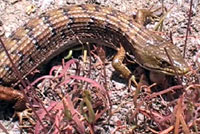 |
 |
| In this video, a Reticulate Gila Monster crawls around, flicking its tongue. |
This night video shows a Desert Banded Gecko crawling slowly and waving its tail back and forth. | In this video, a Southern Alligator Lizard is discovered under a board on a sunny spring afternoon. It tries to bite, crawls across the ground in snake-like fashion, attempts to climb inside or over the camera, sticks out its tongue, then ducks back under its board. | This video shows a Flat-tailed Horned Lizard running rapidly and quickly burying itself in sand with a final fast shake of its short flat tail. |
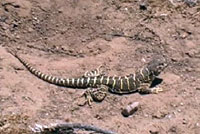 |
 |
 |
 |
| This video shows a large fast-moving adult Blunt-nosed Leopard Lizard resting at the mouth of its burrow then running off into its sparsely-vegetated habitat. |
In this video, two different Coast Horned Lizards are shown running quickly for a short distance then stopping to hide by blending in with the background, a typical defensive behavior for horned lizards. | In this video, a Colorado Desert Fringe-toed Lizard runs slowly, then very quickly over the hot sand. | This video shows a gravid female Sonoran Earless Lizard lowering herself onto her belly and shaking her legs. This might help regulate her temperature. Next we see a male basking on a rock. |
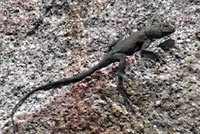 |
 |
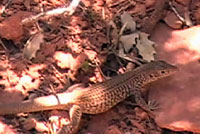 |
 |
| In this video, an adult Mearns' Rock Lizard shows its rock climbing and jumping skills, finally doing a defensive push-up display. Next, a juvenile lizard crawls around the face of a massive rock. | This video shows the slow jerky movements typical of whiptails such as this Great Basin Whiptail. | This video of a Plateau Tiger whiptailshows typical whiptail behavior - slowly walking around, foraging for food at the edge of vegetation, and stopping to dig for food, then racing off across open ground to another location to continue. | In this short video, a large old Panamint Alligator Lizard crawls around in a brush pile at a desert spring , then jumps off and hangs from his tail and hind legs before dropping to the ground and running away. |
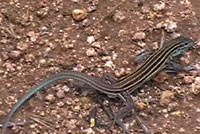 |
 |
 |
 |
| Plateau Striped Whiptails seach and dig for food, then defecate. What goes in, must come out... |
Every time I picked up a tiny Pygmy Short-Horned Lizard and set it down to try to film it in motion, it ran away quickly then stopped only a few feet away, where it remained still until I went to pick it up again, even though there were small bushes nearby that it could have run into to hide. The lizard was not relying on speed to escape, it was relying on its ability to blend in quickly with the background, expecting that I would not see it. |
Australian Lace Monitors escape from danger by climbing very high up a tree. | |
 |
 |
||
| Flying Lizards Lizards in the genus Draco live in trees where they hunt for insects. They are known as flying dragons or flying lizards because they can extend their ribs and the membrane connecting them to make "wings" (patagia) which let them glide long distances from one tree to another. This Draco was photographed on a tree on the island of Sulawesi. It's patagia are extended (with light shining through them) and it appears to be getting ready to glide away. © Steven Caldwell. |
Some lizards become bipedal when they run - they run on their back legs only to move more quickly as this Gilbert's Dragon is doing. |
||
| Lizards Without Legs | |||
| These lizards move on their bellies like a snake. | |||
 |
 |
 |
 |
| Baja California Legless Lizard | Burton's Legless Lizard | The Australian Western Hooded Scaly-foot is a legless lizard that crawls on its belly like a snake, but if you look closely you can see that it has small scaly vestigial limbs. | |
 |
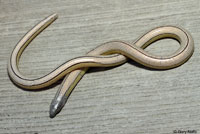 |
 |
 |
| Adult Southern California Legless Lizard, with a recently-detached tail, |
Bakersfield Legless Lizard | Temblor Legless Lizard | Black Legless Lizard |
 |
 |
 |
 |
| A Southern California Legless Lizard writhes around rapidly on a board in this video. Accustomed to living on soft sand it can easily burrow into, it has difficulty moving on the hard surface. | This short video shows Black Legless Lizards burrowing into sand. | This video shows a Southern California Legless Lizard crawling then quickly burrowing into loose soil. | This short video shows a Bakersfield Legless Lizard crawling and burrowing into loose soil. |
 |
|||
| Adult Southern Alligator Lizard, photographed lying still at the edge of a trail in San Luis Obispo County © Joanne Aasen Alligator lizards sometimes tuck their legs along the sides of their body when they move or when they remain still. Sometimes people think they are looking at a snake when they don't see the legs sticking out. |
|||
 |
|||
| Watch a YouTube Video This video that shows how a Southern Alligator Lizard can move on its belly by pulling itself slowly ahead with its front legs while tucking its back legs up against the body to hide them, or maybe just to get them out of the way. This behavior might be an attempt to fool any prospective predators into thinking the lizard is a dangerous snake, not a harmless lizard. © David Van de Houten |
|||
| Lizard Tracks and other Signs of Their Presence | |||
 |
 |
 |
 |
| Fringe-toed prints | Whiptail tracks | Fringe-toed tracks | Lizard tracks |
 |
 |
 |
|
| Desert Iguana tracks |
Horned lizard scat | Iguana carcass | |
Return to the Top
© 2000 -
